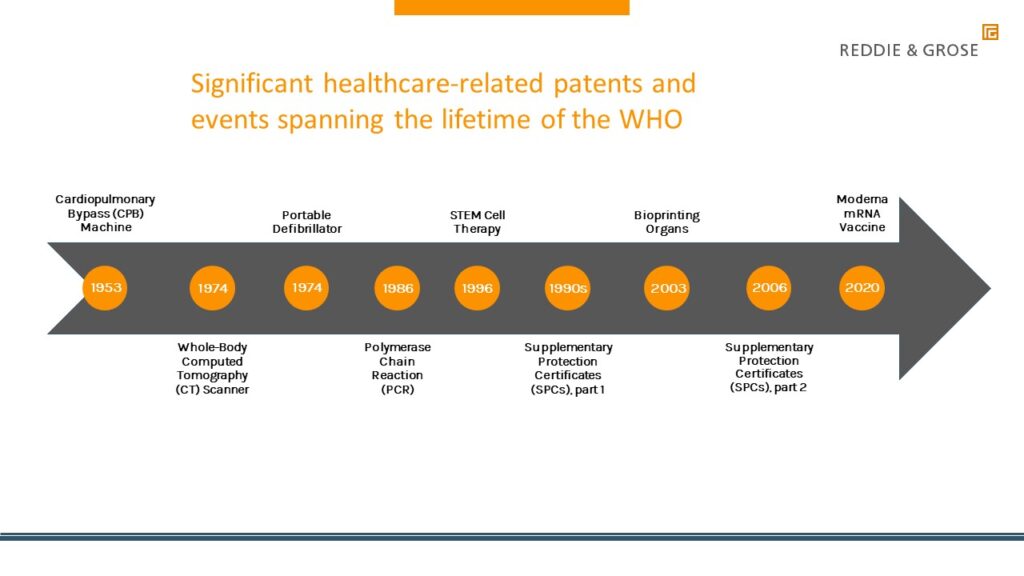06/04/2023
The World Health Organization (WHO) celebrates its 75th birthday tomorrow, 7 April, marking another World Health Day. This is a day observed to spread awareness about both physical and mental health, helping people towards a healthier and happier lifestyle. The focus of this year’s World Health Day is “Health for All”, giving us an opportunity to look back at public health successes that have improved the quality of life during the last seven decades.
Over the lifetime of the WHO, technical innovations have advanced the capabilities of the healthcare system. Through the lens of intellectual property, we have taken a look at a number of significant healthcare-related patents and events spanning the lifetime of the WHO.

1953 – Cardiopulmonary Bypass (CPB) Machine
Oxygenating unit for extracorporeal circulation devices US2702035

Invented by John H Gibbon, the CPB machine, often referred to as the ‘heart-lung machine’, is used to temporarily take over the function of the heart and lungs during surgery. It does so by receiving blood from a patient, oxygenating it, and subsequently returning it to the patient. Since operating on a beating heart is extremely challenging, the CPB machine allows for extracorporeal circulation to significantly reduce the stress on the heart and increase ease of surgery.
A key challenge in designing the machine was achieving sufficient oxygenation of the blood within a reasonable timeframe. To address this, Gibbon devised an arrangement wherein the received blood is manipulated such that it forms a ‘continuous thin film of blood of controllable surface area’ to provide high oxygenation efficiency and yet use only small volumes of blood at a given instant. Gibbon’s CPB machine allowed the first successful open heart procedure to be completed in 1953, and paved the way for future developments in CPB machine design and implementation.
1974 – Whole-Body Computed Tomography (CT) Scanner
Diagnostic X-ray systems US3922552

The first full-body CT scanner was invented by Robert S Ledley, and allowed for the first tomographic (cross-sectional) images to be taken over the entirety of a patient’s body and subsequently processed by a computer. The invention allows for fine rotation and translation of an X-ray source and collector about a patient’s body. In particular, Ledley designed the framework of the scanner such that the rotational movement can be adjusted in increments, allowing a user to alter radiation dosage and the amount of data to be processed. Ledley also introduced the use of a shutter mechanism to interrupt X-ray beams from reaching a patient; previously, water bags were placed in the path of the beams to serve this purpose, with much larger risk posed to user of electronic equipment in the vicinity.
CT scanners are now regarded as highly effective and versatile imaging devices that can assist detection of a wide variety of ailments, notably cancer and coronary artery disease. There is no doubt that Ledley’s invention and subsequent contributions to the design of the scanner were formative. It is interesting to note that both MRI scanners and PET scanners also became commercially available for the first time in the same decade.
1974 – Portable Defibrillator
Defibrillator US4023573

Now present in most public spaces in the UK, portable defibrillators can save a person from cardiac arrest by delivering an electric shock to the heart through the chest wall. Much of the credit for the invention of the portable defibrillator can be attributed to James Francis Pantridge, who recognised that previously available defibrillators were too cumbersome to be transported easily. Previously, defibrillators implemented sizeable batteries which contributed significantly to the weight of the device, meaning that it could only be transported readily in an ambulance.
Pantridge redesigned the defibrillator such that the electrodes, previously located separate to the device, were now integrated with the housing. In doing so, all of the remaining electrical components required to generate the electric shock could be stored within a single, small housing. Pantridge’s first design weighed roughly 70kg, but he went on to design an even smaller defibrillator for NASA only weighing 3kg.
1986 – Polymerase Chain Reaction (PCR)
Process for amplifying, detecting, and/or-cloning nucleic acid sequences US4683195
Readers may recognise the acronym PCR from taking so-called PCR COVID-19 tests, which implement a variant of polymerase chain reaction to copy and replicate virus DNA. However, the technique was invented and pioneered almost 40 years earlier by Kary Mullis.
The technique works by copying and replicating a DNA sample, meaning that only a small sample is required to enable study. This is made possible by treating the DNA with thermal cycles and a number of reagents that cause the DNA strands to be replicated. PCR techniques have become a fundamental technique for studying DNA, and were instrumental in aiding the global COVID-19 testing programme
1996 – STEM Cell Therapy
Primate embryonic stem cells US5843780

Still a nascent area of research today, STEM cell therapy entered the public’s consciousness nearly three decades ago after James A. Thomson filed a patent application for a preparation method of primate embryonic stem cells which could, in theory, be subsequently be used to develop functional cells in an organ or tissue type.
Whilst a US patent was granted in 1998, the corresponding European patent application was, in fact, refused. The matter was escalated to the EPO Enlarged Board of Appeal, which upheld the Examining Division’s decision to refuse the patent. The Examining Division deemed that the application contravened Rule 28(c) EPC, which sets out exceptions to patentability, for example, the use of human embryos for industrial or commercial purposes. Therefore, whilst there is no doubt that this invention has shaped the medical world, it has also had a large impact on the patent world and the consequent patentability of STEM cell inventions.
1990’s – SPCs (part 1)
There may be instances when having patent protection for 20 years simply is not enough.
In the last 75 years, two additional extensions of the 20 year patent term became available.
Firstly, in the 1990s, supplementary protection certificates (SPCs) were introduced to promote innovation by compensating for the time required to obtain regulatory approval of pharmaceutical products (human and veterinary use) and plant protection products. This is to provide an Applicant, who could otherwise not have worked the invention because of an outstanding approval by a regulatory authority, a maximum extra term of protection of 5 years. An SPC is a sui generis IP right which extends the duration of certain rights associated with a patent, which comes into force only after the expiry of the associated patent. SPCs are based on three regulations (EEC No 1768/92 of 18 June 1992, EC No 1610/96 of 23 July 1996, and EC No 469/2009 of 6 May 2009).
2003 – Bioprinting Organs
Ink-jet printing of viable cells US7051654

The organ printing field has grown significantly in the last 20 years, with the eventual aim of producing organs that are fully integrable with a human body. A landmark breakthrough in this field was provided by Thomas Boland in 2003 by using inkjet printing to deposit viable cells on a slide. The above patent was filed in 2003 and subsequently granted in 2006.
Whilst inkjet printing was an established technique prior to Thomson’s invention, it had not been used to create viable cells due to shear stress and temperature constraints in the printing process. However, Thomson made several adaptations to the printing techniques, including placing cells onto a substrate and incubating them at a specific temperature and with a specific mixture of gases. This work has allowed significant advances to be made in organ printing, and inkjet printing remains a major technique for printing even today.
2006 – SPCs (part 2)
The second extension of the 20 year patent term came about in 2006. Since then, an SPC may be extended to a maximum of 5.5 years following a paediatric extension based on two regulations (1901/2006 of 12 December 2006, Directive 2001/20/EC, Directive 2001/83/EC and Regulation (EC) No 726/2004).
2020 – Moderna mRNA Vaccine
Betacoronavirus mRNA vaccine US10702600
Of this list, perhaps one of the most significant patents is that of the Moderna mRNA vaccine. With the emergence of the COVID-19 pandemic, there were, unsurprisingly, a flurry of patent applications filed for various coronavirus vaccines. Moderna appear to be the first Applicant to apply for protection for an mRNA COVID vaccine.
mRNA vaccines use copies of the so-called messenger RNA (mRNA) molecules to trigger an immune response, differing from traditional vaccines that often use inactivated pathogens. Whilst mRNA vaccines have been in development for a number of decades now, there is no doubt that this invention, alongside other mRNA coronavirus vaccines have been instrumental in rapidly accelerating advances in this field. Yet further, this invention has brought mRNA vaccines into the public consciousness, and has played a significant part in lives around the world.
Clearly, these are just a few examples of the many advances made in the field of healthcare, and we hope such life-changing innovations will continue (perhaps this is what the WHO will wish for when blowing out the 75 candles on their cake). It has been particularly interesting seeing how the technology has shifted over the course of the WHO’s lifetime. In recent years, particular growth is seen in the digital healthcare sector, a technology sector falling on the interface of healthcare and digital technologies.
At Reddie & Grose, our experienced Life Sciences team and multidisciplinary Medical Devices and Digital Healthcare team are on hand to advise on IP in relation to healthcare including the IP challenges of the Medical Technology industry and to provide advice for seeking and securing patent protection.
This article is for general information only. Its content is not a statement of the law on any subject and does not constitute advice. Please contact Reddie & Grose LLP for advice before taking any action in reliance on it.





